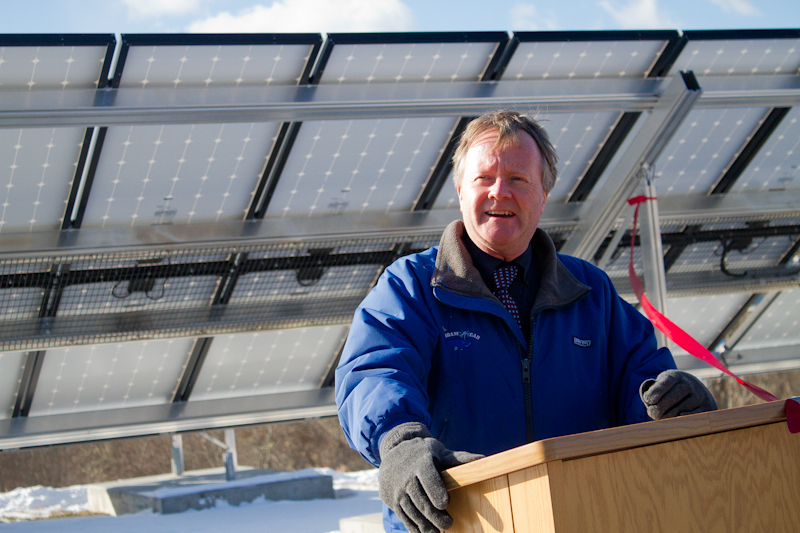At exactly 10 a.m. on Wednesday morning, a beam of sunshine peeked out from behind a cloud to envelop a treeless hill in Aquinnah in golden light. A small crowd, bundled up against the 15-degree chill, had gathered at the town landfill, but at the morning’s ribbon-cutting ceremony for Aquinnah’s first-ever solar array project, the sun was the guest of honor.
“This is really a great occasion for all of us to be here today,” Aquinnah town administrator Adam Wilson told the onlookers, shortly before selectman Jim Newman snipped the official red ribbon.
The completed project, which features 200 photovoltaic panels, now powers all town-owned buildings and street lights in Aquinnah. It is the first solar array on a landfill on Martha’s Vineyard, the third in southeastern Massachusetts, and just the fifth in the entire state, Mr. Wilson said.
“It’s been an amazing experience for all of us involved,” said Mr. Wilson.
Paul Pimental, chairman of the board of the Vineyard Power cooperative, added to Mr. Wilson’s remarks, commending Aquinnah for “taking the lead and initiative, and driving forward a lot of things that were brand new.”
The solar array was developed by Vineyard Power, with funding from co-op members and Vineyard summer residents Lee and Julie Moncton and the Edgartown National Bank. It was constructed by South Mountain Company, making it a truly Island-grown project.
“Part of our missions is to keep money local [and] keep ownership local,” Vineyard Power general manager Erik Peckar told the Gazette.
The town of Aquinnah first approved the project at a special town meeting in December of 2011. The article was the only item on the warrant, and was approved 29-13. Construction began last July. The array, a 50-kilowatt system, went online on Dec. 19.
South Mountain energy manager Rob Meyers estimated that it produces between 60,000 to 65,000 kilowatt hours of energy per year, more than enough to meet the town’s needs. Mr. Wilson noted that because the town calculated its needs prior to an energy audit — replacing tungsten bulbs with CFL lights, among other tasks — the unit is expected to yield a surplus of solar power.
“In the short run, it reduces cost nominally,” he said. But over time, the array will save Aquinnah about $10,000 per year, and after 10 years, the town has the option to purchase the array from Vineyard Power. If that comes to pass, Mr. Wilson said, Aquinnah’s municipal energy costs will be zero.
South Mountain project designer and overseer Darrill Bazzy is also an Aquinnah resident.
“That made it really fun,” he said. “I was proud of Aquinnah for being so willing to do it — the selectmen worked really hard to get it started.”
“Whether in Aquinnah or another town, it just makes such sense for solar to be on a landfill,” Mr. Bazzy added. Solar arrays can only be built on capped landfills, which have barriers between the refuse and the rest of the environment.
“You’re using space that’s already committed . . . without taking away from valuable agricultural land,” Mr. Pimentel said. Vineyard Power’s previous energy projects, the two solar arrays in the parking lots of down-Island Cronig’s, also repurpose space, a tactic that Mr. Pimentel said “carries through a philosophical approach to renewable energy.”
The town of Tisbury is currently developing a capped-landfill solar array, and similar projects are planned for Chilmark and West Tisbury. A solar array owned by contractor Bill Bennett, which provides electricity for the Charter School, the YMCA, the Edgartown National Bank, and the Tisbury Farm Market and Vineyard Grocer, went online in December.
“After it’s there you think, ‘Why didn’t we do this before?’” Mr. Pimentel said.








Comments (2)
Comments
Comment policy »